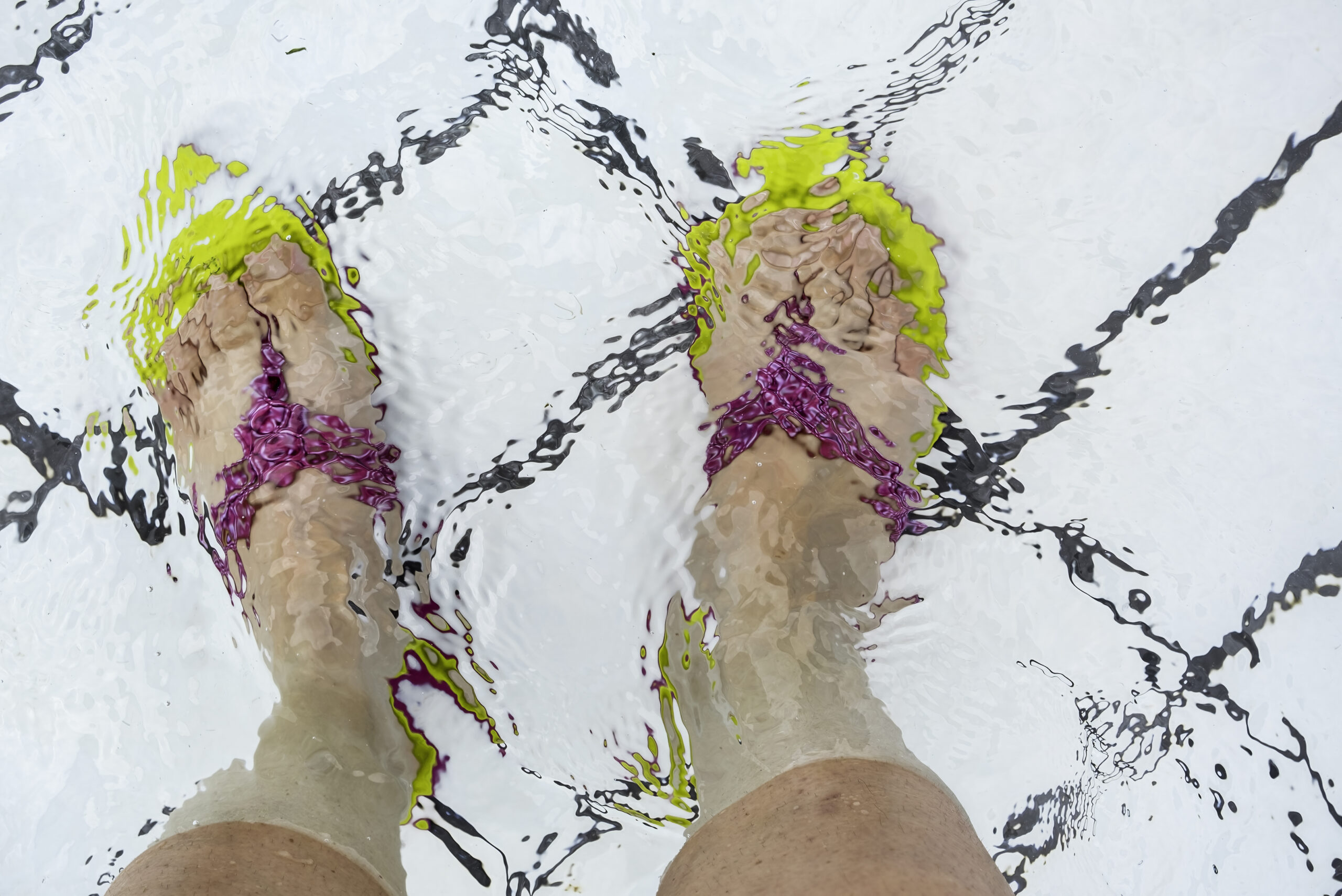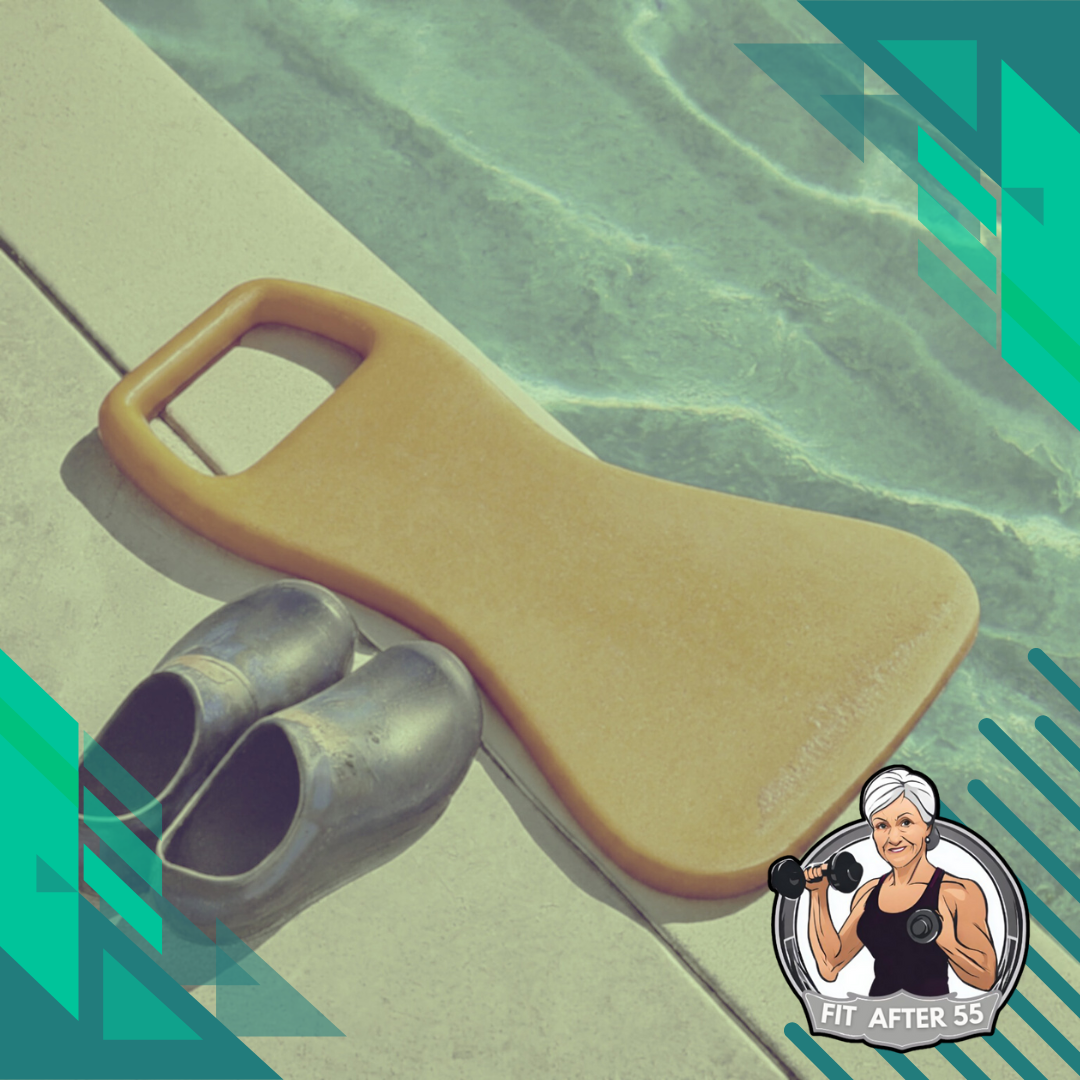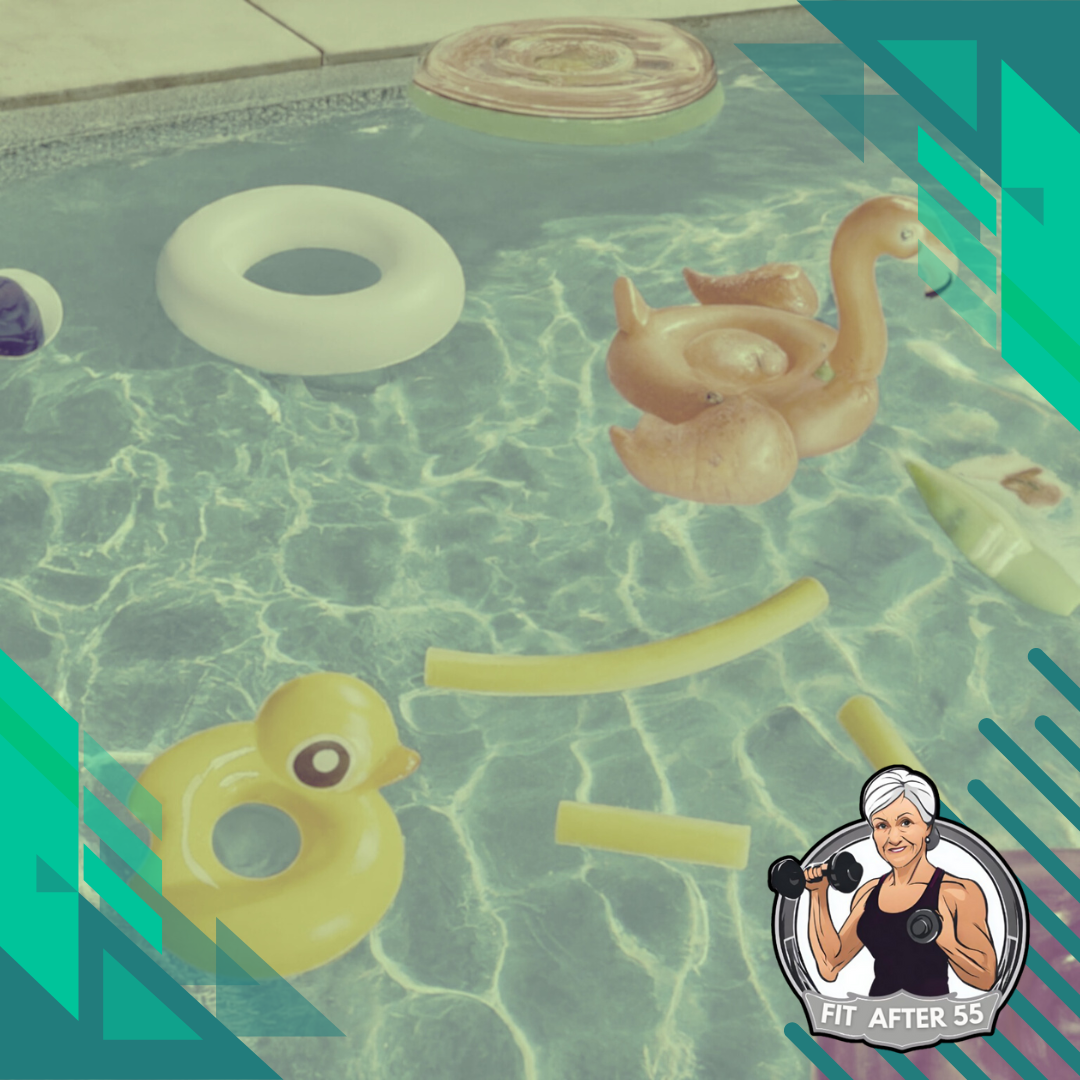Benefits of water walking extend far beyond a refreshing dip on a hot day. As we get older, staying active becomes even more crucial for maintaining good health and well-being. But let’s face it, traditional high-impact exercises can be tough on our joints. Here’s where water walking steps in, offering a gentle yet effective way to keep your body moving and your spirits high. It’s low-impact, refreshing, and surprisingly fun – perfect for anyone in their fifties and beyond looking to boost their fitness without the strain.
Benefits of Water Walking: Fun and Effective Fitness
Looking for a fun, low-impact way to boost your fitness? When I discovered the incredible benefits of water walking for fitness, I was hooked! I love swimming so adding water walking was easy for me. But even people who don’t know how to swim can take advantage of this fitness routine safely.

Walking in water is an excellent cardio and resistance training exercise option. This gentle exercise takes the pressure off your bones and joints while still providing a great workout.

Water walking isn’t just good for your body; it’s also a great way to socialize and have fun.
Imagine moving through the water with friends, feeling the buoyancy support you as you work your muscles. Plus, it’s versatile—you can adjust the depth and intensity to suit your fitness level.
Water walking offers something for everyone, whether you’re a beginner or looking to mix up your routine. Keep reading to learn how you can integrate this exercise into your fitness plan and make the most out of your workouts.

Key Takeaways
- Water walking is a low-impact exercise that strengthens muscles.
- It can be customized for any fitness level.
- Combining fitness with social activities makes it enjoyable.
What Is Water Walking?
Water walking is a way to exercise in a swimming pool. It is gentle on the joints, making it perfect for people of all ages and fitness levels.
The Basic Concept of Water Walking
Water walking is simply walking in a pool. The water provides resistance, which makes your muscles work harder compared to walking on land.
This exercise is especially helpful for people with joint pain or those recovering from injuries. The buoyancy of water reduces the pressure on your joints while still giving you a great workout. Plus, you can adjust the depth of the water to make the exercise easier or harder.
Types of Water Walking
There are different ways to do water walking:
- Forward Walking: This is just like walking on land but in water. It’s great for your legs and core muscles.
- Backward Walking: This targets different muscles, especially in your legs and lower back.
- Sideways Walking: Moving sideways in water can help strengthen your hip and thigh muscles.
- High Knees: Lifting your knees higher adds extra challenge and works more muscles.
You can also add equipment like water weights or resistance bands to make your workout even harder. Classes or group exercises can be a fun way to stay motivated and meet new people while getting fit.
Water walking is versatile and can meet most fitness needs and goals.
Health Benefits of Water Walking
Water walking offers various health benefits, making it an excellent choice for fitness and well-being. The exercise can enhance cardiovascular health, support joint and muscle function, aid in weight loss, and promote mental health.

Cardiovascular Improvement
One of the main benefits of water walking is its positive effect on cardiovascular health.
Walking in water increases your heart rate, improving circulation and heart function. This gentle exercise can be a great option if you’re looking to improve your cardiovascular endurance without putting too much strain on your body.
Being submerged in water also helps reduce blood pressure because of the hydrostatic pressure. This can make your heart pump more efficiently. Regular water walking sessions can lead to a healthier heart and better overall circulation.
Joint and Muscle Benefits
Water walking is gentle on the joints because the buoyancy of water reduces the impact on bones and joints. This makes it perfect for anyone dealing with arthritis or joint pain.
The water’s resistance helps strengthen muscles without causing stress or injury.
For those with balance issues, water provides support and stability, reducing the risk of falls.
Engaging multiple muscle groups, water walking helps tone and strengthen muscles, which can improve overall muscle endurance and stability over time.
Calorie Burning and Weight Loss
Water walking can aid in weight loss by burning calories through low-impact exercise.
The resistance from water requires more effort, thus burning more calories compared to walking on land. Combining water walking with a healthy diet can help you achieve your weight loss goals.
For a deeper burn, try increasing the intensity by jogging or adding water weights. This will provide an effective workout, helping you shed pounds while being gentle on your body. Keeping a consistent routine can make a big difference in maintaining a healthy weight.
Stress Reduction and Mental Health
Exercise in water can be incredibly soothing and stress-relieving.
The calming effect of water can help reduce stress and anxiety. Water walking is a great way to relax while still getting an effective workout.
Being in water can also improve mood and mental health. The sense of weightlessness and the gentle motion can help release endorphins and improve overall feelings of happiness.
This makes water walking a fantastic option for improving both physical and mental well-being.
Getting Started with Water Walking
Getting started with water walking is easy and enjoyable. You just need some basic gear and a few simple techniques to begin.

Essential Gear for Water Walking
To start, you’ll need a swimsuit that is comfortable and allows for easy movement.
Since water walking often happens in a pool, water shoes can be very helpful. They provide grip and protect your feet from rough surfaces.
Next, consider using flotation devices such as a buoyancy belt. This can help you stay upright and balanced.
Sometimes, water dumbbells or resistance gloves are useful to add an extra level of resistance to your routine. These can increase the intensity of your workout, making it more effective.
Lastly, bring a water bottle to stay hydrated. It’s easy to forget to drink water when you’re in the pool, but staying hydrated is important.
Basic Techniques for Beginners
Begin by walking in the shallow end of the pool.
Keep your back straight and your shoulders relaxed.
Move as you would on land, with one foot stepping in front of the other. This helps you get used to the resistance of the water.
As you get more comfortable, try increasing your walking speed or moving to deeper water.
This will add more resistance and make your workout more challenging.
Swing your arms as you walk to help with balance and to engage your upper body.
Another great technique is marching. Lift your knees high with each step. This can help strengthen your legs and improve your balance.
Remember to keep your movements controlled and steady. This makes the exercise safer and more effective.
Making Water Walking Fun
Adding games and challenges can make water walking more enjoyable. Joining groups can enhance motivation and create a community atmosphere.

Incorporating Games and Challenges
Games and challenges can transform a basic water walking routine into an exciting activity.
I like to include relay races, which not only add a competitive element but also boost cardio.
Setting up floating markers as obstacles can make the workout more engaging and help with agility and coordination.
One idea is to balance a floating object while walking. It’s a fun way to improve core strength.
You can also try water polo or volleyball in shallow water for a mix of cardio and upper body exercise. These games keep me focused and motivated.
For a solo challenge, I set time goals or track the distance walked.
Adjusting the intensity by varying walking speeds or adding aqua weights can also make the workout more fun and challenging. This variety not only keeps the routine fresh but also ensures a full-body workout.
Joining Water Walking Groups
Joining a group can make water walking more enjoyable and social.
I find that group classes provide great motivation and accountability. It’s easier to stick to a routine when others are involved.
Water walking groups often include structured routines led by instructors. This can introduce new exercises and techniques.
Being part of a group also creates a sense of community. I enjoy meeting new people and sharing the experience.
Participating in group challenges or themed workouts, like a Hawaiian luau or a pirate treasure hunt, can add a fun aspect.
These themed activities keep the workouts light-hearted and enjoyable. Plus, the group setting encourages camaraderie and makes exercising feel less like a chore.
Advanced Water Walking Techniques
Incorporating advanced techniques into your water walking routine can boost your fitness level significantly. By focusing on speed and endurance, as well as utilizing weights and resistance tools, you can achieve a more effective workout.

Speed and Endurance Training
Interval Training: In the pool, alternate between fast-paced walking and slower recovery periods. This method enhances cardiovascular health and builds endurance.
High Knees: Lift your knees high during each step. This not only increases your heart rate but also engages your core muscles.
Lateral Walking: Walk sideways to target different muscle groups. Make sure to switch directions to balance the workout.
Using Weights and Resistance Tools
Water Weights: Incorporate weights specifically designed for water use. These increase resistance and help build muscle strength without overly straining joints.
Resistance Bands: Attach resistance bands to the pool’s edge and perform leg lifts, arm curls, or kickbacks.
This can intensify your workout and target specific muscles.
Buoyancy Belts: Use a buoyancy belt to stay afloat while focusing on upper body movements. This allows for a full-body workout and adds variety to your routine.
Integrating Water Walking into Your Fitness Routine
Water walking is a great way to add variety to your exercise routine. By planning your workouts and combining them with other activities, you can get the most out of your time in the pool.
Creating a Water Walking Workout Plan
To get started, decide how often you want to walk in the water each week. You might aim for two to three times a week.
Begin with a warm-up by walking slowly for five to ten minutes to get used to the water and prepare your muscles.
Next, increase your pace for 15 to 20 minutes. If you’re new, start with shorter intervals and gradually extend your walking time as your fitness improves.
Focus on maintaining good form by keeping your back straight and swinging your arms naturally.
You can add variety by changing the direction—such as walking backward or sideways—and using different water depths.
Shallow water is easier, while deeper water adds resistance, making the workout harder. This variation helps target different muscle groups and keeps the exercise exciting.
Cross-Training with Other Water Activities
Splitting your routine with other water activities can enhance your fitness and prevent boredom. Some good options include swimming, water aerobics, and aqua jogging.
These activities not only provide a cardio boost but also help with strength and flexibility.
I often combine water walking with swimming laps. For instance, I might swim two laps, then walk briskly in the water for five minutes, and repeat this cycle.
This mix keeps my heart rate up and works different muscle groups.
Water aerobics classes are another fun way to stay fit. They typically include a mix of cardio and strength exercises, and the social aspect can be motivating.
Plus, using equipment like water weights or foam noodles can add resistance and make the workout more challenging.
By planning diverse workouts and combining them with other pool exercises, you can enjoy a well-rounded and engaging fitness routine.
Reap the Rewards: The Many Benefits of Water Walking
So, we’ve explored the refreshing world of water walking and discovered a multitude of benefits for those in their fifties and beyond. It’s a low-impact exercise that’s gentle on your joints, perfect for those recovering from injuries or managing chronic pain. Water walking strengthens your heart and improves circulation, while also aiding in weight management and boosting your mood. Plus, the social aspects of group water walking classes can add a layer of fun and motivation to your fitness routine.

Ready to dive in and experience the transformative power of water walking? Find your swimsuit, grab a water bottle, and head to your local pool. You might just surprise yourself with how much you enjoy this invigorating and effective form of exercise!

Frequently Asked Questions
Below, I’ll tackle some of the most common queries to help you get started with this fun and effective exercise.
How does water walking compare to walking on land for improving fitness?
Water walking provide s low-impact resistance due to the water’s natural properties. This resistance helps strengthen muscles more efficiently while being gentle on joints.
Unlike walking on land, water walking can improve cardiovascular fitness with less strain on the body, making it ideal for various fitness levels.
Is water walking an effective way to aid in weight loss?
Yes, water walking can help with weight loss. The resistance provided by water increases calorie burn compared to walking on land.
Plus, buoyancy reduces the risk of injury, allowing for longer workouts. Studies show that consistent water walking can contribute to effective weight management and overall health improvements.
Can water walking exercises benefit seniors in particular?
Absolutely, water walking is particularly beneficial for seniors. The buoyancy of water reduces stress on aging joints and bones.
It also helps improve balance, flexibility, and muscle strength without the high risk of injuries associated with other forms of exercise.
What are the advantages of walking backwards in water?
Walking backwards in water can enhance muscle tone and flexibility. This movement targets different muscle groups than walking forward, providing a more comprehensive workout.
It also helps with balance and coordination, which are crucial for overall fitness. Many find it a fun and challenging addition to their routine.
How long should a typical water walking workout last?
A typical water walking workout should last between 30 to 60 minutes, depending on your fitness level and goals.
Start with a shorter session and gradually increase the duration as your endurance improves. Consistency is key for seeing benefits, so aim for regular sessions throughout the week to maximize results.
Are there specific benefits to knee health from engaging in water walking?
Yes, water walking is excellent for knee health. The water’s buoyancy reduces stress on the knees, making it ideal for individuals with arthritis or recovering from injury.
Also, the resistance helps build muscle strength around the knee, providing better support and stability. This can lead to improved mobility and reduced pain over time.
And for a full-body workout, check out this article by The New York Times.
Stay Fit, Find Fun: Your Active Life Starts Here at Fit After 55!
Looking for fitness inspiration and a supportive community? Fit After 55 (fit-after-55.com) is your one-stop shop! We offer engaging content, insightful product reviews, and a warm welcome to anyone on their fitness journey. Join our Facebook group (https://www.facebook.com/profile.php?id=61557390788711) to connect with like-minded individuals and get the most out of your active life!

